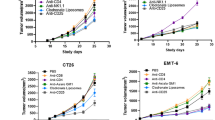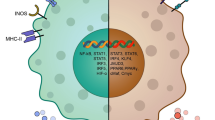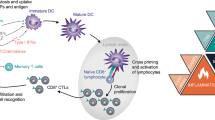Abstract
In vitro macrophage-or TNF-α-mediated selection procedures on 3LL tumor cells have led to the selection of 3LL variants manifesting a highly reduced sensitivity towards the cytotoxic effects of both TNF-α and tumoricidal macrophages, while retaining the parental sensitivity to the cytolytic activity of (i) H2O2, (ii) macrophage-ADCC reactions and (iii) NK cells. A correlation was observed between the TNF-α binding capacity of the 3LL cell lines and their susceptibility towards macrophage-and TNF-α-mediated cytotoxicity, indicating that macrophage and TNF-α sensitivity may partially be regulated at the TNF-α receptor level. Further, the selected 3LL variants are gene-regulatory variants rather than cellular mutants, as upregulation of the TNF-α receptor by interferon-gamma (IFN-γ) or 5′-azacytidine treatment resulted in an increased vulnerability of the selected 3LL variants to the killing activity of macrophages and TNF-α. The resistance of the 3LL variants to macrophage-and TNF-αmediated cytotoxicityin vitro was reflected by a higher tumorigenic and metastatic potentialin vivo. Therefore, the generation of TNF-α-and macrophage-resistant variants through immunoselection may contribute to the basic mechanisms of tumor progression and metastasis.
Similar content being viewed by others
References
Adams, D. O., 1980, Effector mechanisms of cytolytically activated macrophages. I. Secretion of neutral proteases and effect of protease inhibitors.Journal of Immunology,124, 286–292.
Adams, D. O., andNathan, C. F., 1983, Molecular mechanisms operative in cytolysis of tumor cells by activated macrophages.Immunology Today,4, 166–170.
Aggarwal, B. B., Eessalu, T. E., andHass, P. E., 1985, Characterization of receptors for human tumour necrosis factor and their regulation by gamma-interferon.Nature (London),318, 665–667.
Altevogt, P., von Hoegen, P., andSchirrmacher, V., 1986, Immunoresistant metastatic tumor variants can re-express their tumor antigen after treatment with DNA methylation-inhibiting agents.International Journal of Cancer,38, 707–712.
Bouwens, L., Remels, L., Baekeland, M., Van Bossuyt, H., andWisse, E., 1987, Large granular lymphocytes or ‘Pit cells’ from rat liver: isolation, ultrastructural characterization and natural killer activity.European Journal of Immunology,17, 37–42.
Boon, T., 1983, Antigenic tumor cell variants obtained with mutagens.Advances in Cancer Research,39, 121–151.
Carswell, E. A., Old, L. J., Kassel, R. L., Green, S., Fiore, N., andWilliamson, B., 1975, An endotoxin-induced serum factor that causes necrosis of tumors.Proceedings of the National Academy of Sciences of the U.S.A.,72, 3666–3670.
Cheung, H. T., Cantarow, W. D., andSundharadas, G., 1979, Characteristics of alow molecular weight factor extracted from mouse tumors that affectsin vitro properties of macrophages.International Journal of Cancer,23, 344–349.
Currie, G. A., 1978, Activated macrophages kill tumor cells by releasing arginase.Nature (London),273, 758–759.
De Baetselier, P., Brys, L., Vercauteren, L., Mussche, L., Hamers, R., andSchram, E., 1984, Generation of continuous macrophage-hybridomas for the study of macrophage chemiluminescence.Analytical Applications of Bioluminescence and Chemiluminescence, edited by L. J. Kricka, P. E. Stanley, G. H. G. Thorpe and T. P. Whitehead (NewYork: Academic Press), pp. 297–305.
Evans, R., andAlexander, P., 1972, Mechanism of immunologically specific killing of tumour cells by macrophages.Nature (London),236, 168–170.
Fogler, W. E., andFidler, I. J., 1985, Nonselective destruction of murine neoplastic cells by syngeneic tumoricidal macrophages.Cancer Research,45, 14–18.
Fransen, L., Van der Heyden, J., Ruysschaert, M. R., andFiers, W., 1986, Recombinant tumor necrosis factor: its effect and its synergism with interferon-γ on a variety of normal and transformed human cell lines.European Journal of Cancer and Clinical Oncology,22, 419–426.
Frost, P., Liteplo, R. G., Donaghue, T. P., andKerbel, R. S., 1984, Selection of strongly immunogenic “tum”-variants from tumors at high frequency using 5′-azacytidine.Journal of Experimental Medicine,159, 1491–1501.
Hass, P. E., Hotchkiss, A., Mohler, M., andAggarwall, B. B., 1985, Characterization of specific high affinity receptors for human tumor necrosis factor on mouse fibroblasts.Journal of Biological Chemistry,260, 122214–12218.
Hibbs, J. B. Jr, Lambert, L. H., andRemington, J. S., 1972, Possible role of macrophage mediated nonspecific cytotoxicity in tumor resistance.Nature (London),235, 48–50.
Hibbs, J. B. Jr, Lambert, L. H., andRemington, J. S., 1972, Control of carcinogenesis: a possible role for the activated macrophage.Science,177, 998–1000.
Kramer, J. J., andGranger, G. A., 1972, Thein vitro induction and release of a cell toxin by immune C57BL/6 mouse peritoneal macrophages.Cellular Immunology,3, 88–100.
Meltzer, M. S., 1981, Macrophage activation for tumor cytotoxicity: characterization of priming and trigger signals during lymphokine activation.Journal of Immunology,127, 179–183.
Nathan, C. F., Karnovsky, M. L., andDavid, J. R., 1971, Alterations of macrophage functions by mediators from lymphocytes.J ournal of Experimental Medicine,133, 1356–1376.
Nathan, C. F., Brukner, L. H., Silverstein, S. C., andCohn, Z. A., 1979, Extracellular cytolysis by activated macrophages and granulocytes. II. Hydrogen peroxide as a mediator of cytotoxicity.Journal of Experimental Medicine,149, 84–99.
Pace, J. L., andRussell, S. W., 1981, Activation of mouse macrophages for tumor cell killing.Journal of Immunology,126, 1863–1867.
Pluznik, D. H., andSachs, L., 1965, The cloning of normal “mast” cells in tissue culture.Journal of Cellular and Comparative Physiology,66, 319–324.
Remels, L. M., andDe Baetselier, C. P., 1987, Characterization of 3LL-tumor variants generated byin vitro macrophage-mediated selection.International Journal of Cancer,39, 343–352.
Remels, L., Fransen, L., Huygen, K., andDe Baetselier, C. P., 1988, Immunological aspects of tumor-macrophage interactions.Cancer Metastasis;Biological and Biochemical Mechanisms and Clinical Aspects, edited by K. Hellmann, L. A. Liotta, G. Prodi, P.-L. Lollini, S. Garbisa, and S. Gorini (New York: Plenum Publishing Corporation), pp. 49–59.
Rubin, B. Y., Anderson, S. L., Sullivan, S. A., Williamson, B. D., Carswell, E. A., andOld, L. J., 1985, High affinity binding of125I-labeled human tumor necrosis factor (LuKII) to specific cell surface receptors.Journal of Experimental Medicine,162, 1099–1104.
Shalaby, M. R., Palladino, M. R., Hirabayashi, S. E., Eessalu, T. E., Lewis, G. D., Shepard, H. M., andAggarwal, B. B. 1987, Receptor binding and activation of polymorphonuclear neutrophils by tumor necrosis factor-α.Journal of Leukocyte Biology,41, 196–204.
Szuro-Sudol, A., andNathan, C. F., 1982, Suppression of macrophage oxidative metabolism by products of malignant and non-malignant cells.Journal of Experimental Medicine,156, 945–961.
Urban, J. L., 1981, Macrophage-induced enhancement of endogenous tumor lysosome activity.Cancer Research,41, 2221–2228.
Urban, J. L., Burton, R. C., Holland, J. M., Kripke, M. L., andSchreiber, H., 1983, Mechanisms of syngeneic tumor rejection. Susceptibility of host-selected progression variants by the normal host.Journal of Experimental Medicine,155, 557–573.
Urban, J. L., Shepard, H. M., Rothstein, J. L., Sugarman, B. J., andSchreiber, H., 1986, Tumor necrosis factor: a potent effector molecule for tumor cell killing by activated macrophages.Proceedings of the National Academy of Sciences of the U.S.A.,83, 5233–5237.
Author information
Authors and Affiliations
Rights and permissions
About this article
Cite this article
Remels, L., Neirynck, A., Brys, L. et al. TNF-α mediated selection of macrophage-resistant gene-regulatory tumor variants. Clin Exp Metast 7, 493–506 (1989). https://doi.org/10.1007/BF01753810
Received:
Accepted:
Issue Date:
DOI: https://doi.org/10.1007/BF01753810




